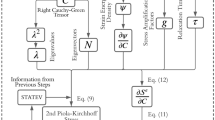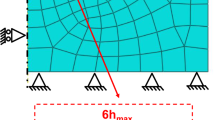Abstract
In this article, we focus our attention on the relation between instrumented indentation tests and the prediction by means of finite element calculations. To this end, a finite strain viscoplasticity model of Perzyna-type with non-linear isotropic and kinematic hardening is calibrated at experimental data of steel S690QL. A particular concept for conducting uniaxial tensile and compression tests is taken up in order to represent the basic rate-dependent material behavior. In this respect, an algorithmic framework of material parameter identification using finite elements is proposed leading to a two-stage procedure in the case of the underlying rate-dependent constitutive model. On the basis of the termination points of relaxation the rate-independent equilibrium stress state can be identified and all viscous parts of the model are obtained using rate-dependent loading paths. Finally, use is made of finite elements for predicting indentation experiments, which results in a critical view on modeling and parameter identification on the basis of experimental results occurring in instrumented indentation tests.
Similar content being viewed by others
References
ISO14577 (2002) ISO 14577: instrumented indentation testing. Beuth Verlag, Berlin.
Heermant C, Dengel D (1996) Klassische Werkstoffkennwerte abschätzen. Materialprüfung 38:374–378.
Venkatesh T, Van Vliet K, Giannakopoulos A, Suresh S (2000) Determination of elasto-plastic properties by instrumented sharp indendation: guidelines for property extraction. Scr Mater 42:833–839.
Taljat B, Zacharia T, Kosel F (1998) New analytical procedure to determine stress-strain curve from spherical indentation data. Int J Solids Struct 35:4411–4426.
Kokubo S (1932) On the change in hardness of a plate caused by bending. Sci Rep Tohuko Imp Univ, Ser 1 21:256–267.
Sines G, Carlson R (1952) Hardness measurements for determination of residual stresses. ASTM Bull 34–37.
Swadener J, Taljat B, Pharr G (2001) Measurement of residual stress by load and depth sensing indentation with spherical indenters. J Mater Res 71:16.
Suresh S, Giannakopolous A (1996) A new method for estimating residual stresses by instrumentated sharp indentation. Acta Metall Mater 46:5755–5767.
Field J, Swain M (1995) Determining the mechanical properties of small volumes of material from submicrometer spherical indentation. J Mater Res 10:101–112.
Gibmeier J (2003) Zum Einfluss von Last- und Eigenspannungen auf die Ergebnisse instrumentierter Eindringhärteprüfungen. PhD thesis, University of Kassel, Institute of Materials Research, Kassel (Germany).
Huber N, Tsakmakis C (1999) Determination of constitutive properties from spherical indentation data using neural networks, Part I: plasticity with nonlinear and kinematic hardening. J Mech Phys Solids 47:1589–1607.
Huber N, Tsakmakis C (1999) Determination of constitutive properties from spherical indentation data using neural networks, Part II: the case of pure kinematic hardening in plasticity laws. J Mech Phys Solids 47:1569–1588.
Haupt P, Lion A (1995) Experimental identification and mathematical modelling of viscoplastic material behavior. J Contin Mech Thermodyn 7:73–96.
Haupt P (2000) Continuum mechanics and theory of materials. Springer Verlag, Berlin.
Tsakmakis C (1996) Kinematic hardening rules in finite plasticity. Part I: A constitutive approach. Contin Mech Thermodyn 8:215–231.
Lämmer H (1998) Thermoplastizität und Thermoviskoplastizität mit Schädigung bei kleinen und großen Deformationen. Technical Report FZKA 6053. Forschungszentrum Karlsruhe, Karlsruhe (Germany).
Diegele E, Jansohn W, Tsakmakis C (2000) Finite deformation plasticity and viscoplasticity laws exhibiting nonlinear hardening rules. Part I: Constitutive theory and numerical integration. Comput Mech 25:1–12.
Andresen K, Dannemeyer S, Friebe H, Mahnken R, Ritter R, Stein E (1996) Parameteridentifikation für ein plastisches Stoffgesetz mit FE-Methoden und Rasterverfahren. Bauingenieur 71:21–31.
Gelin J-C, Ghouati O (1996) An inverse solution procedure for material parameters identification in large plastic deformations. Commun Numer Methods Eng 12:161–173.
Mahnken R, Stein E (1996) A unified approach for parameter identification of inelastic material models in the frame of the finite element method. Comput Methods Appl Mech Eng 136:225–258.
Mahnken R, Stein E (1997) Parameter identification for finite deformation elasto-plasticity in principal directions. Comput Methods Appl Mech Eng 147:17–39.
Kreißig R (1998) Auswertung inhomogener Verschiebungsfelder zur Identifikation der Parameter elastisch-plastischer Deformationsgesetze. Forsch Ingwes 64:99–109.
Scheday G, Miehe C (2001) Parameteridentifikation finiter Elastizität bei inhomogenen Deformationen. ZAMM Z Angew Math Mech 81(Suppl 2):S425–S426.
Hartmann S, Haupt P, Tschöpe T (2001) Parameter identification with a direct search method using finite elements. In: Besdo D, Schuster R, Ihlemann J (eds) Constitutive models of rubber II. Balkema, Lisse, pp 249–256.
Hartmann S, Tschöpe T, Schreiber L, Haupt P (2003) Large deformations of a carbon black-filled rubber. Experiment optical measurement and parameter identification using finite elements. Eur J Mech A, Solids 22:309–324.
Powell M (1994) A direct search optimization method that models the objective and constraint functions by linear interpolations. In: Gomez S, Hennart J (eds) Advances in optimization and numerical analysis. Kluwer Academic, Dordrecht, pp 51–67.
Powell M (1998) Direct search algorithms for optimization calculations. Acta Numer 7:287–336 (see internet address: http://plato.la.asu.edu/topics/problems/nlores.html).
Gibmeier J, Hartmann S, Scholtes B (2004) Effect of applied and residual stresses on the analysis of mechanical properties using instrumented indentation techniques. In: 7th International Conference on Residual Stresses, Xian, China.
Haupt P (1993) On the mathematical modelling of material behavior in continuum mechanics. Acta Mech 100:129–154.
Hartmann S (1993) Lösung von Randwertaufgaben der Elastoplastizität. Ein Finite-Elemente-Konzept für nichtlineare kinematische Verfestigung bei kleinen und finiten Verzerrungen. Doctoral thesis, Institute of Mechanics, University of Kassel. Report No. 1/1993.
Hartmann S, Lührs G (1994) Ein Finite-Elemente-Konzept für nichtlineare kinematische Verfestigung bei kleinen und finiten plastischen Deformationen. In: Bruhns O (ed) Große plastische Formänderungen, volume 93 of Reports of the Institute ofMechanics. Ruhr-Universität Bochum, pp101–104.
Dettmer W, Reese S (2004). On the theoretical and numerical modelling of Armstrong-Frederick kinematic hardening in the finite strain regime. Comput Methods Appl Mech Eng 193:87–116.
Lührs G, Hartmann S, Haupt P (1997) On the numerical treatment of finite deformations in elastoviscoplasticity. Comput Methods Appl Mech Eng 144:1–21.
Diegele E, Hartmann S, Tsakmakis C (2000) Finite deformation plasticity and viscoplasticity laws exhibiting nonlinear hardening rules. Part II: Representative examples. Comput Mech 25:13–27.
Chaboche J, Rousselier G (1983) On the plastic and viscoplastic constitutive equations — Part I Rules developed with internal variable concept. J Press Vessel Technol 105:153–158.
Armstrong P, Frederick C (1966) A mathematical representation of the multiaxial Bauschinger effect. Technical Report General Electricity Generating Board, Report No.: RD/B/N731, Berceley Nuclear Laboratories.
Ellsiepen P, Hartmann S (2001) Remarks on the interpretation of current non-linear finite-element-analyses as differential-algebraic equations. Int J Numer Methods Eng 51:679–707.
Haupt P, Kamlah M, Tsakmakis C (1992) On the thermodynamics of rate-independent plasticity as an asymptotic limit of viscoplasticity for slow processes. In: Besdo D, Stein E (eds) Finite inelastic deformations — theory and applications. IUTAM Symposium Hannover/Germany, Springer, pp 107–116, Berlin.
Huber N, Tsakmakis C (1998) A finite element analysis of the effect of hardening rules on the indentation test. J Eng Mater Technol 120:143–148.
Lee H, Lee J, Pharr G (2005) A numerical approach to spherical indentation techniques for material property evaluation. J Mech Phys Solids 53:2037–2069.
Lemaitre J, Chaboche J-L (1990) Mechanics of solid materials. Cambridge University Press, Cambridge.
Hartmann S, Lührs G, Haupt P (1997) An efficient stress algorithm with applications in viscoplasticity and plasticity. Int J Numer Methods Eng 40:991–1013.
ABAQUS (1998). ABAQUS theory manual, v.5.8 edition.
Author information
Authors and Affiliations
Corresponding author
Rights and permissions
About this article
Cite this article
Hartmann, S., Gibmeier, J. & Scholtes, B. Experiments and Material Parameter Identification Using Finite Elements. Uniaxial Tests and Validation Using Instrumented Indentation Tests. Exp Mech 46, 5–18 (2006). https://doi.org/10.1007/s11340-006-5857-2
Received:
Accepted:
Published:
Issue Date:
DOI: https://doi.org/10.1007/s11340-006-5857-2




